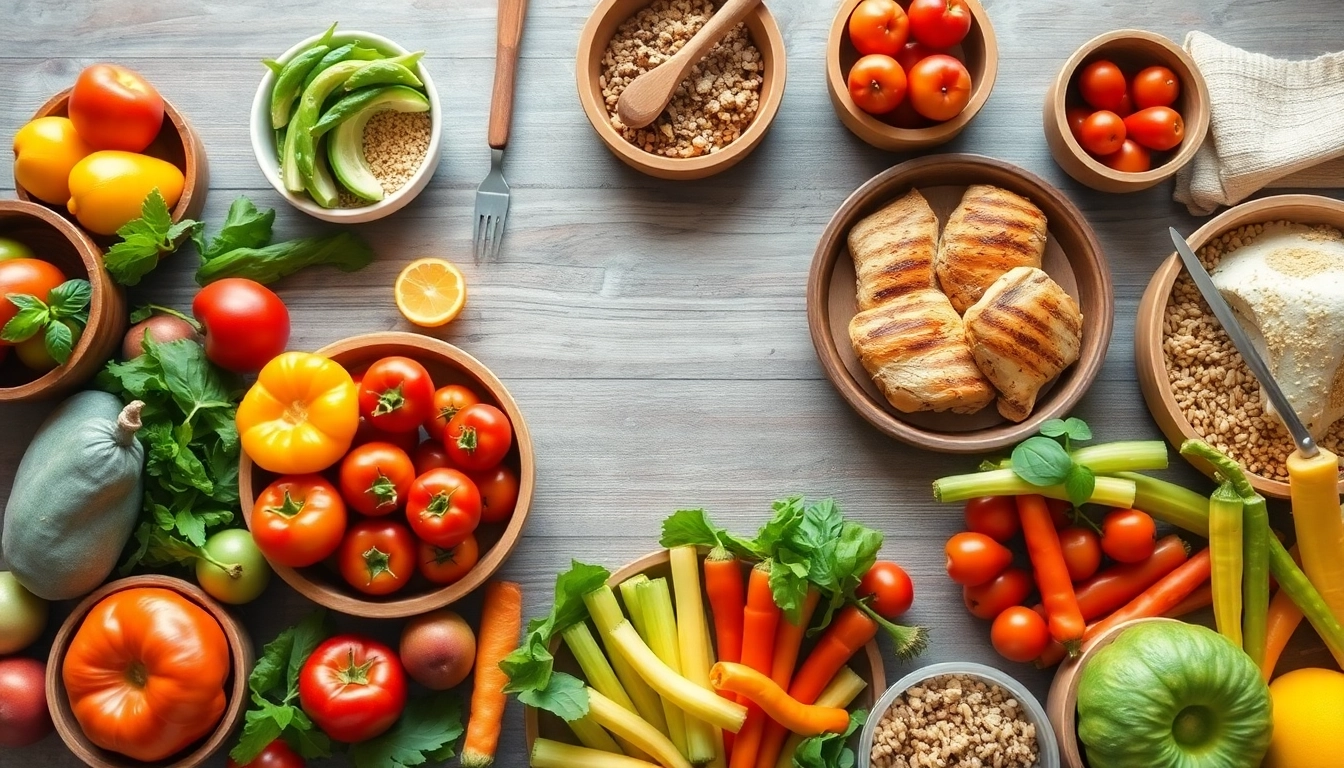Understanding Healthy Food: A Comprehensive Guide
In today’s fast-paced world, the importance of healthy food cannot be overstated. With so many options available, it can be challenging to navigate through the clutter to understand what truly constitutes healthy eating. The essence of a balanced diet lies not only in the type of food we consume but also in ensuring that these foods contribute positively to our overall health. In this article, we’ll explore various facets of healthy food, including its definitions, benefits, misconceptions, and practical ways to incorporate it into your daily routine. To initiate your journey towards healthier eating habits, consider learning more about Healthy Food and its various components.
1. What is Healthy Food?
Healthy food refers to a variety of foods that provide essential nutrients to the body, including vitamins, minerals, protein, carbohydrates, and healthy fats. These foods promote overall health and help prevent chronic diseases such as obesity, diabetes, and heart disease. A balanced diet typically includes a variety of fruits, vegetables, whole grains, lean proteins, and healthy fats – all of which contribute significantly to maintaining energy levels and improving one’s quality of life. Understanding the role of each food group is crucial in making informed choices about what to eat.
2. Benefits of Eating Healthy Food
The benefits of consuming healthy food are far-reaching and can improve various aspects of physical and mental health. Here are some key benefits:
- Weight Management: Eating nutritious foods helps regulate body weight and can prevent obesity.
- Reduced Disease Risk: A diet rich in fruits, vegetables, and whole grains is associated with a lower risk of chronic diseases.
- Improved Mood: Nutrient-rich foods have been linked to enhanced mood and mental well-being.
- Higher Energy Levels: Consuming the right balance of nutrients fuels the body and provides sustained energy throughout the day.
- Stronger Immunity: A healthy diet can bolster your immune system, improving your body’s ability to fight infections.
3. Common Misconceptions About Healthy Food
Despite the wealth of information available, many misconceptions about healthy eating persist. Addressing these myths is essential for better dietary choices:
- Myth 1: Healthy foods are always more expensive. While some healthy items can cost more, budgeting and planning can make nutritious foods affordable.
- Myth 2: All fats are bad. In reality, healthy fats (like those from avocados and nuts) are beneficial for health.
- Myth 3: You need to completely eliminate carbs to be healthy. The right types of carbohydrates, such as whole grains and legumes, are vital for energy and health.
Key Healthy Foods to Include in Your Diet
1. Fruits and Vegetables: Nature’s Powerhouses
Fruits and vegetables form the backbone of a healthy diet. Packed with vitamins, antioxidants, and fiber, they are essential for promoting health and preventing diseases. Incorporating a variety of colors on your plate not only makes meals visually appealing but also ensures a range of nutrients. Some notable options include:
- Leafy Greens: Spinach, kale, and collard greens are high in vitamins A, C, and K.
- Berries: Blueberries, strawberries, and raspberries are rich in antioxidants and have numerous health benefits.
- Citrus Fruits: Oranges, lemons, and grapefruits provide vitamin C and enhance immune function.
- Cruciferous Vegetables: Broccoli and cauliflower contain compounds that may reduce cancer risk.
2. Whole Grains: Fueling Your Day
Whole grains are an essential source of energy and provide an array of nutrients, including fiber, vitamins, and minerals. Unlike refined grains, whole grains retain their nutritional value, promoting better digestion and sustained energy levels. Examples of healthy whole grains include:
- Brown Rice: A versatile and filling grain that is higher in fiber compared to white rice.
- Quinoa: A gluten-free grain high in protein and essential amino acids.
- Oats: An excellent breakfast choice that helps lower cholesterol levels.
3. Lean Proteins: Building Blocks of Health
Protein plays a crucial role in the body, forming the building blocks of muscles, organs, and tissues. Choosing lean protein sources can provide health benefits while reducing the risk of heart disease. Some great options include:
- Fish: Salmon and mackerel are rich in omega-3 fatty acids, which are beneficial for heart health.
- Poultry: Skinless chicken and turkey are lower in saturated fat compared to red meat.
- Legumes: Beans, lentils, and chickpeas are excellent plant-based protein sources high in fiber.
Healthy Food Recipes for Every Meal
1. Breakfast: Energizing Your Morning
Starting the day with a nutritious breakfast can set the tone for healthier eating throughout the day. Consider these healthy breakfast recipes:
- Overnight Oats: Combine oats, yogurt, and fruits for a quick and filling meal.
- Green Smoothie: Blend spinach, banana, almond milk, and a tablespoon of peanut butter for an energy boost.
- Avocado Toast: Whole-grain bread topped with avocado, poached eggs, and a sprinkle of salt and pepper.
2. Lunch: Creating Balanced Midday Meals
Lunch is an opportunity to recharge. Ensure your midday meal is balanced and nutritious:
- Quinoa Salad: Mix cooked quinoa with vegetables, herbs, and a light vinaigrette for a refreshing salad.
- Whole Grain Wrap: Fill a whole grain wrap with turkey, leafy greens, and hummus.
- Vegetable Stir-Fry: Sauté different colorful vegetables with tofu or chicken for a quick, protein-packed meal.
3. Dinner: Satisfying and Nutritious Options
Dinner can be a time to gather and enjoy a nutritious family meal. Here are some healthy dinner ideas:
- Baked Salmon: Serve with a side of steamed broccoli and quinoa.
- Grilled Chicken: Accompanied by a side of roasted sweet potatoes and green beans.
- Vegetarian Chili: A hearty mix of beans, vegetables, and spices.
Shopping for Healthy Food: Tips and Tricks
1. How to Choose Fresh Produce
Selecting fresh produce is vital for maximizing nutrition and taste. Here are some tips:
- Seasonal Choices: Choose fruits and vegetables that are in season for the best flavor and price.
- Check for Ripeness: Look for natural colors and avoid overly bruised or damaged items.
- Buy Organic When Possible: If you’re concerned about pesticides, opt for organic options for dirty dozen fruits and veggies.
2. Understanding Food Labels
Reading and understanding food labels can guide healthier choices. Pay attention to:
- Serving Sizes: Determine the appropriate serving size to avoid consuming excess calories.
- Nutritional Information: Check for calories, sugar, sodium, and fat content.
- Ingredients List: Look for whole foods and avoid items with many artificial ingredients.
3. Budget-Friendly Healthy Food Shopping
Eating healthy doesn’t have to break the bank. Here are some strategies:
- Plan Meals: Create a meal plan for the week to avoid impulse purchases.
- Buy in Bulk: Purchase grains, nuts, and seeds in bulk to save money.
- Use Coupons: Take advantage of coupons and discounts for healthy products.
Overcoming Challenges in Maintaining Healthy Eating
1. Managing Time and Meal Prep
Time constraints often lead to unhealthy eating. Here are ways to efficiently manage meal prep:
- Batch Cooking: Prepare meals in larger quantities and freeze portions for later use.
- Quick Recipes: Focus on recipes that require minimal cooking time.
- Invest in Storage Containers: Use clear containers to organize and store healthy meals and snacks.
2. Social Situations and Healthy Choices
Social events can pose challenges for maintaining healthy eating habits. Here’s how to navigate them:
- Plan Ahead: Look at menus beforehand to choose healthy options.
- Eat Beforehand: Having a nutritious snack before social gatherings can minimize unhealthy choices.
- Be Assertive: Don’t hesitate to stick to your food choices and politely decline unhealthy temptations.
3. Overcoming Emotional Eating with Healthy Food
Emotional eating can sabotage your efforts towards healthy eating. Combat this by:
- Differentiating Emotions: Recognize whether you are truly hungry or eating due to emotional triggers.
- Healthier Alternatives: Keep healthy snacks on hand to replace unhealthy comfort foods.
- Mindfulness Training: Practice mindfulness techniques to enhance your awareness of eating habits.



